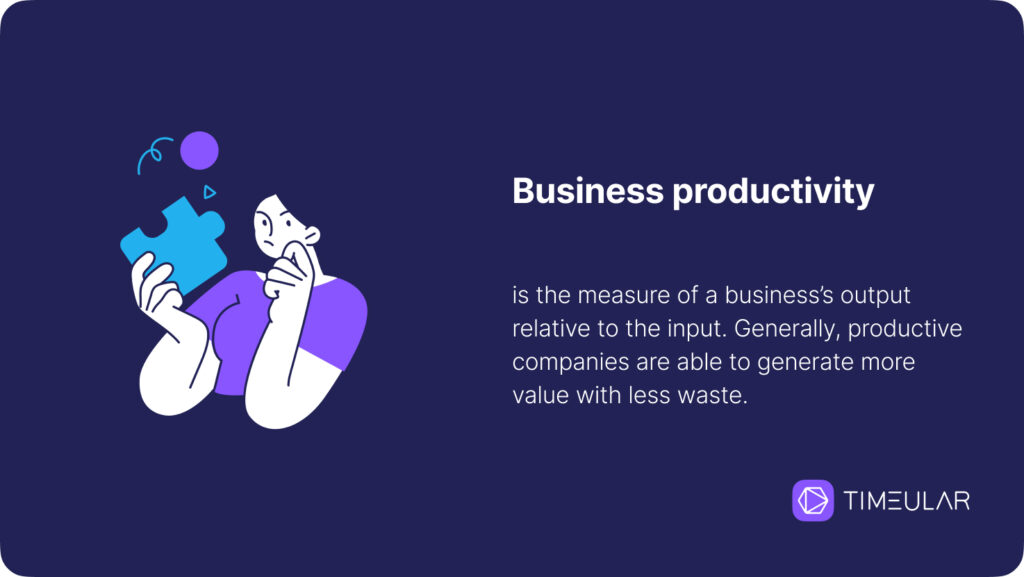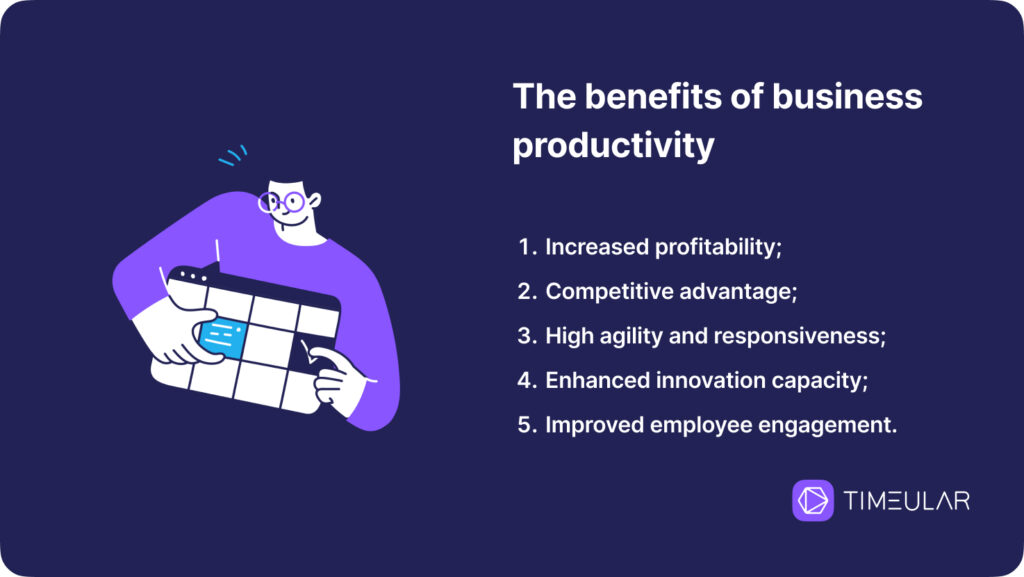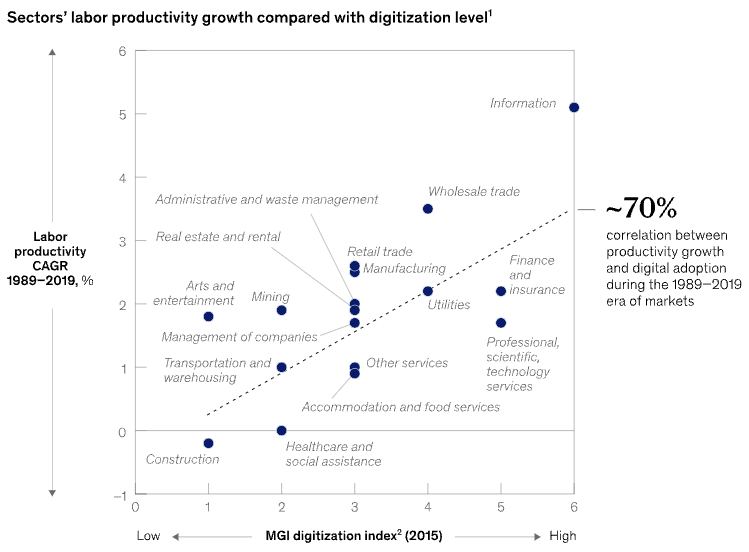Business Productivity Reinvented: Ways to Stay Ahead
Business productivity is consistently at the top of the priority list for any business leader, and not only. It’s no surprise that this happens.
Data shows employee disengagement could cost medium-sized S&P businesses between $228 and $355 million annually in wasted productivity. (McKinsey study linked at the bottom of the article.) Hence, let’s dive into some practical and proven methods business leaders can use to improve productivity.
In this article, you will:
Learn the critical metrics to assess and boost business productivity;
Discover how digitization led to the highest productivity in four business sectors in the US between 1989 and 2019;
- Understand how a simple productivity tracker can impact many business processes and increase productivity;
Gain insights into unconventional productivity hacks, from flat structures to gamification.
What is business productivity?
Productivity is the measure of a business’s output relative to the input.
Macroeconomics explains that business productivity measures how efficiently a company converts inputs, such as capital and labor, into outputs, like products or services. The equation is the value of services and products produced divided by the amount of labor and capital used in its production.
Therefore, the main metrics companies measure when assessing business productivity are capital productivity and labor productivity. Capital productivity measures physical capital like raw materials, energy costs, office equipment, software, and hardware tools, while labor productivity measures labor costs, work hours, and others.

Generally, productive companies are able to generate more value with less waste, and it is not just about doing things quickly but doing the right things – the things that actually move the needle for their business.
Concluding, business productivity refers to the efficiency and effectiveness of a company’s operations. It’s about maximizing output while minimizing input and doing so in a way that aligns with the organization’s strategic goals.
Key metrics to measure productivity
In order to maximize productivity, there are a few key metrics you need to assess to ensure that you’re measuring the real impact on your bottom line.
Here are some examples:
Labor productivity: This is the classic productivity metric, measuring the output per hour of work. It can be simply calculated with time-tracking apps.
Project completion rates: For project-based work, tracking the percentage of projects completed on time and on budget is an important productivity indicator. It helps identify bottlenecks and areas where more resources are needed.
Total factor productivity (TFP): TFP takes into account not just labor but also capital investments like equipment and technology. It’s a more comprehensive measure of how efficiently a company is using all of its resources.
Gross value added (GVA): GVA measures the total value of goods and services produced by a company minus the cost of intermediate inputs. It’s a useful metric for assessing the overall productivity and economic contribution of a business.
Revenue per employee: This metric assesses the total revenue generated divided by the number of employees. It’s a good way to measure the overall productivity and profitability of your workforce.
Employee satisfaction and engagement: While harder to quantify, employee satisfaction and engagement are critical drivers of productivity. Metrics like employee Net Promoter Score (eNPS) and absenteeism rates can give you a sense of how motivated and committed your team is.
Capacity utilization: This metric measures the percentage of total available work hours that are actually being used productively so you can understand if your staff is underutilized or overutilized.
By regularly tracking these metrics, you can get a data-driven picture of your team’s productivity and make informed decisions about where to focus your productivity improvements.
The key to improving productivity is to not just measure productivity but to use those measurements to drive continuous improvement.

Why does business productivity matter?
Before we jump into the nitty-gritty of productivity strategies, it’s important to take a step back and address the question of why business productivity even matters and what the real impact on your bottom line is.
The benefits of a highly productive business are nothing short of game-changing. Here are some benefits:
Increased profitability: When your team is firing on all cylinders, you can get more done in less time, which translates to lower costs and higher profits. In other words, you’re reaching economies of scale. It’s a simple equation, but by increasing productivity, your business can be better equipped to generate higher profits and charge lower prices with the same resources invested.
Competitive advantage: One of the fastest and best ways to stay ahead of the curve and outpace your competitors is to adapt and innovate quickly. Once you improve productivity, you’re on the way to coming out on top quicker than your competition.
High agility and responsiveness: Productive businesses are often better at communicating and streamlining their decision-making processes. Hence, this enables business leaders and teams to react quickly to market changes, customer needs, or internal challenges.
Enhanced innovation capacity: Efficient operations will free up your time and resources that can be directed toward R&D and innovation. This way, you’re driving a continuous improvement of products and services while keeping your business at the forefront of your industry.
Improved employee engagement: When productivity increases through efficient processes and better tools, employees often feel less stressed and more engaged. This boosts morale and individual productivity, which leads to higher retention rates, reduced absenteeism, and a stronger company culture.
Top strategies to boost productivity
1. Capitalize on digitization and automation
A McKinsey study on productivity reveals that they identified a 70% correlation between productivity growth and digital adoption between 1989 and 2019 among companies from the US.
The information sectors, including software, telecommunications, and internet publishing, have had the highest productivity increase, with an average of 5,5% growth since 2005.
On the other side of the spectrum, service-led sectors such as accommodation and food services or healthcare saw the lowest productivity growth and are among the least productive industries.

Source: Rekindling US productivity for a new era, McKinsey.
The conclusion is simple: Start adding technology layers to all your processes, streamline operations, and automate all your time wasters.
Implementing only one tool into our tech stack can cover many business needs. For example, an AI time-tracker can do the following for you:
Generate reports automatically on how time is spent on tasks so you can quickly identify operational blockers and stay on top of employee productivity;
Manage resource allocation better, based on real-time progress on projects;
Capture billable hours in case you need to bill accurately to clients or identify profitability blockers;
Manage all types of time off without an additional leave tracker;
Generate payroll timesheets automatically;
Understand trends in team and personal productivity trends,
Stay on top of your team’s mental health by tracking their overtime hours;

Record and report all time-related and productivity matters without constantly switching between tools with Timeular, the most effortless and smart time-tracking app.
In essence, such a tool determines the future of your internal process, identifies what daily tasks consume most work hours, understands work habits, recognizes patterns, and gains a deeper understanding of where the time goes.
- Note that, when tracking employees’s time, it’s best to choose an anti-surveillance and privacy-first tool like Timeular, as there are considerable downsides to monitoring employees.
2. Adjust your business strategy to match your digital transformation
McKinsey research found that companies typically realize only 25% to 30% of the expected value from digitalization. The shortfall, according to their research, lies in the lack of updating their business strategy or model to augment the digital transformation.
The same research found that frontier firms that increase productivity due to digitization set new business goals enabled by technology. Simply said, they reconfigure their businesses in order to digitize operations that can capture the benefits of technology.
Therefore, once you digitize processes in your own business, to have guaranteed increased productivity, you need to adjust your business strategies.

If pivoting to a business model or strategy sounds like an extensive complex project, here are simple and small steps to start with in boosting productivity:
Begin by identifying one or two key areas where technology can significantly impact productivity in the workplace. For example, if you own a retail business, you could start by implementing an inventory management system to streamline your stock control and ordering processes.
Implement digital collaboration platforms to improve communication and productivity among team members. If you own a small marketing agency, you could adopt AI-powered project management tools to streamline workflows and ensure deadlines are met.
3. Build a future-proof workforce
Leaders win the talent war once they recognize the value of their employees, invest in their professional development, and prioritize their job growth. The options available are to either disproportionately secure and invest in-house in skilled talent to leverage technology or attract top talent. This process can take many forms:
- Providing mentorship opportunities
- Investing in online learning platforms
- Encouraging cross-functional training
- Enrolling them in boot camps
The list can continue, but the main traits of a future-proof workforce are adaptability, innovation, and equipping employees to leverage new technologies for increased productivity.
4. Foster a time-conscious culture
One of the biggest productivity killers is wasting time in meetings, with emails, or by working without a structure or time management strategies. So, here are some strategies that contribute to a better relationship with time and better productivity:
- Implement a “No meeting day”: Designate one day per week where no internal meetings are allowed, giving employees uninterrupted time to focus on deep work and individual tasks. By the way, do you know how many work hours there are in a year?
Adopt a “20% time” policy: Allow your team to spend 20% of their work time on self-directed projects related to the company’s goals, fostering innovation and creativity and dedicating their time to what they feel matters and impacts the business most.
Implement timeboxing: Encourage employees to allocate fixed time periods for specific tasks, as this helps them increase focus and prevent overtime work or project delays.
Biorhythm-based scheduling: Allow employees to work during their most productive hours based on their individual circadian rhythms, which could mean different start times for different team members.
Did you know that even a simple method like Don’t Break the Chain, the productivity method that made Seinfeld a legend, can have a big impact on your team’s productivity?

Make sure their time is well spent by managing it with automatic, smart and secure time tracking apps.
Unconventional ways of improving workplace productivity
Productivity is driven by many elements in a work environment. It can be a result of how employees feel in relation to failure, whether they delegate tasks or not, or their personal productivity techniques or lack thereof.
Nonetheless, there are unconventional and effortless ways to boost productivity without investing in expensive tech or changing your business strategy altogether. Here are some simple examples:
“Failure walls”: Create spaces where employees can share their failures and lessons learned so you can foster a culture of experimentation and continuous improvement.
Holacracy or flat organizational structures: Implement self-management systems that distribute authority and decision-making throughout the organization. Flat structures have a high potential of generating business growth and high productivity as they increase the agility of a business.
Adopt a results-only work environment (ROWE): Focus on outcomes rather than labor hours worked and other similar metrics, as in this way, you’re assessing metrics that have a direct impact on your organization, and you’re giving employees more autonomy over when and how they complete their tasks.
Foster co-creation with hackathons for internal processes: Organize regular events where cross-functional teams work intensively on solving internal challenges or improving company processes.
Use artificial intelligence for administrative tasks(and not only): Implement AI-powered tools to handle routine, repetitive tasks so you and your team free up time for more complex and creative work.
Use gamification: Incorporate game-like elements into work processes to increase engagement and motivation, such as point systems, leaderboards, or badges for completing tasks or reaching goals.
It’s high time you increased productivity
You’re now equipped with some of the most effective strategies to improve business productivity. Remember, you don’t have to implement all of these strategies at once. Start small, experiment with different techniques, and see what works best for your unique team and business.
The key is to stay consistent and committed to the process. Productivity isn’t a one-and-done thing – it’s an ongoing journey that requires constant iteration and improvement. You’ll slowly be able to take on bigger challenges, innovate more quickly, and ultimately, drive more success for your business.
FAQ
What is meant by productivity in business?
Productivity in business means that a business produces an output that is bigger and more lucrative relative to the input it invests in to obtain the output.
How do you measure business productivity?
You measure business productivity by dividing the value of services and products produced by the amount of labor and capital used in its production.
What is a productive business?
A productive business refers to the efficiency and effectiveness of a company’s operations. Generally, productive companies are able to generate more value with less waste, and it is not just about doing things quickly but doing the right things – the things that actually move the needle for their business. It’s about maximizing output while minimizing input and doing so in a way that aligns with the organization’s strategic goals.
What are the 3 types of productivity?
Among productivity types, you’ll find labor productivity, capital productivity, or total factor productivity (TFP).
Source: